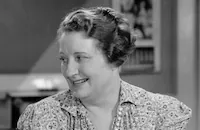House by the River

Brief Synopsis
Cast & Crew
Fritz Lang
Louis Hayward
Jane Wyatt
Lee Bowman
Dorothy Patrick
Ann Shoemaker
Film Details
Technical Specs

Synopsis
In the 1890s, in the back garden of his elegant Victorian house on the banks of a river, unsuccessful novelist Stephen Byrne struggles with his latest manuscript. When the maid, Emily Gaunt, asks Stephen for permission to use the upstairs bath, he blithely agrees as his wife Marjorie has gone out. Emily finishes her bath, borrows one of Marjorie's bathrobes and begins down the dark stairwell. From his place in the shadows, Stephen suddenly emerges and begins kissing Emily. When Emily begins to scream, Stephen notices that his gossipy neighbor, Mrs. Ambrose, has wandered close to the front door. Fearing a scandal, Stephen grabs Emily's throat to prevent her from screaming, but strangles her instead. A few minutes later, Stephen's lame brother John arrives, and Stephen begs him for help. Together, they wrap the body in an old wood sack and dump it into the flood-prone river. That evening, at a party hosted by socialite Mrs. Whittaker, John watches with disgust as Stephen amuses the guests with his drunken merriment. By the time Stephen and Marjorie, who is pregnant, return from the party, their housekeeper, Mrs. Beach, has already informed the police of Emily's disappearance. To create suspicion against Emily, Stephen hides a pair of Marjorie's earrings and she later reports them missing. Weeks later, John's housekeeper, Flora Bantam, repeats the rumor that Emily stole the earrings before quitting and leaving town. In town, John sees a display in a bookstore window featuring Stephen's new novel, Night Laughter , a thinly veiled account of Emily's murder. Later, Mrs. Bantam phones John at the office and asks him to retrieve the wood sack that he lent to Stephen. Realizing that she is referring to the sack in which they wrapped Emily's body, John gives her an excuse. Then Mrs. Bantam tells John that before he lent the sack to Stephen, she had his name stenciled on it. Sometime later, after Mrs. Ambrose spots the sack floating in the river, Stephen frantically boards his rowboat and chases after it. The sack floats away, however, and the next day, when police inspector Sarten visits his house holding the sack in his hand, Stephen tells him that it was stolen from his shed. When the case goes to court, Marjorie testifies that around the time of Emily's disappearance, she noticed that a pair of earrings had been taken. The next witness, Mrs. Bantam, testifies that after Emily's disappearance, John became so irritable that she was forced to leave his employment. Later, because of the evidence mounting against him, Marjorie fears that John may try to commit suicide. She begs Stephen to speak with him, and the brothers meet at the boat launch. There, Stephen tells John that the notoriety of Emily's murder has turned his novel into a bestseller. Fearing that his brother will reveal their secret, Stephen beats John with a section of heavy chain link, dumps his unconscious body into the river and returns home to begin work on Death in the River . When Stephen calmly tells Marjorie that he was unable to prevent John's suicide, she realizes that her own life is in danger. Just then, John arrives, still dripping water from the river, and Stephen believes that he is seeing John's ghost. Stephen is so terrified that he becomes tangled in a heavy curtain at the top of the stairs and falls to his death below.

Director

Fritz Lang
Cast

Louis Hayward

Jane Wyatt

Lee Bowman

Dorothy Patrick

Ann Shoemaker
Jody Gilbert

Peter Brocco
Howland Chamberlin
Margaret Seddon
Sarah Padden

Kathleen Freeman

Will Wright
Leslie Kimmell
Effie Laird
George Taylor
Alex Gerry
Watson Downs
Frank Dae

Carl "alfalfa" Switzer
William Fawcett
Candy Mcdowell
Judy Sochor
Edgar Caldwell
Ethel Greenwood
Edythe Elliott
Frank Jacquet
Edward Clark
Crew
George Antheil
R. Dale Butts
Edward Cronjager
Henry Cronjager
Joe Dill
Mel Dinelli
Tad Gillum
Peggy Gray
John Grubbs
Arthur D. Hilton
Louise Landmeir
Boris Leven
Howard Lydecker
Theodore Lydecker
Bob Mark
Nels Mathias
John Mccarthy Jr.
Adele Palmer
Robert Peters
Arthur Roberts
Howard Smit
Sid Swaney
Charles Thompson
Dick Tyler
Howard Welsch
Howard Wilson
Dorothy Yutzi

Film Details
Technical Specs

Articles
The House By the River - Fritz Lang's THE HOUSE BY THE RIVER on DVD
While The House By the River still suffers from a banal screenplay, under production, and depressing dialogue, the film is still pock-marked with simple, dark, elegant sequences in the director's style. The film is probably best know for its murder sequence - which is still effective in its combination of perversion, eroticism, and symbolism. Although the plot is boilerplate, it's fascinating to see the director slow the story down for the protagonist to flick a bug off his manuscript, make a hand mirror something ominous, or put actor Louis Hayward through a Mabuse-like crawl of terror. It's evident that although Lang was making films on the cheap, he was still trying to make them stark, effective, clever, and entertaining.
Kino has uncovered a suitable print from the National Film and Television Archive in London for this release - certainly better than the film has looked in previous prints since the dawn of video. Although the print used here, likely an intermediate positive print, is banged up at the typical reel end/beginning points, it's in overall great shape, with decent blacks and soft grays free of major wear. This DVD release includes a photo gallery of mostly lobby cards, and an interesting though too brief 5 minute interview with noted film historian Pierre Rissient created by Variety film critic Todd McCarthy.
The DVD packaging lists the copyright for the film as Repix Inc., and the DVD lists the following: "Motion Picture based on the novel "House By the River" by AP Herbert. Underlying literary rights reverted to AP Herbert 1959. Literary rights licensed exclusively to Pierre Rissient 1966" indicating both Rissient's long love and involvement with the film and his apparent interest in remake rights.
For more information about The House By the River, visit Kino International. To order The House By the River, go to TCM Shopping.
by Richard Steiner

The House By the River - Fritz Lang's THE HOUSE BY THE RIVER on DVD
Quotes
Trivia
'Fritz Lang' originally wanted a black woman to play the role of Emily Gaunt but the producers refused.
Notes
The working title of this film was Floodtide. Although Arthur Hilton is credited onscreen as editor, Hollywood Reporter production charts list Arthur Roberts as the editor.

Miscellaneous Notes
Released in United States 1950
Released in United States May 1990
Shown at Cannes Film Festival (Fritz Lang Tribute) May 10-21, 1990.
Released in United States May 1990 (Shown at Cannes Film Festival (Fritz Lang Tribute) May 10-21, 1990.)
Released in United States 1950













